

VOLUME 12 • ISSUE 4 • APRIL 2023 • ARTS & CULTURE
pg 25
From Sketch to screen


Welcome to the newest issue of C Magazine! Spring is a season marked by transitions as the weather gets warmer, flowers bloom and the days lengthen. Here at C Mag, spring is home to another important transition: the turning over from one leadership team to the next. As we close out our time as editors, we want to thank you all for being right along our side, supporting us throughout our journey. We truly couldn’t do it without you.
The transition from the pages of a book, to the frames of a movie is not always made smoothly as reported by writers Amalia Tormala, Lily Daniel and Sophia Zhang. “Reading Between the Frames” on page 10 studies when movie adaptations of books were made well, and what makes them successful.

As those with siblings know, having a brother or sister can be a built in best friend — or enemy. On page 18, “Built-inBesties” by Sarah Bakhash and Ria Mirchandani, weighs the pros and cons of being related to your classmates.
Our cover features.. Often overlooked and belittled by live action movie fans, animation offers a medium in which truly


every single detail is created from scratch. Arjun Bharat, Alice Sheffer, Martina Meyerfreund and Kaitlyn Gonzalez Arceo explore the ins and outs of the animation industry, in “From Sketch to Screen” on page 25.
We’ve written about talented artists who are students countless times before, but rarely do we focus on teachers for our Featured Artist series. “FA: Paly Art Teachers” on page 34 does just that, as Kayley Ko, Fallon Porter and Sophia Dong talk to several teachers who have artistic passions.
This issue marks the end of our tenure as editors, representing a culmination of the past 12 months of work. But don’t fear, our new leaders are capable and passionate, ready to both finish off this year of scholastic journalism, and power C Mag to the future. Keep up with the future of C Mag either in print with our next and final issue of the 202324 school year, or in the meantime, online, at cmagazine.org.
Happy
Scarlett Cummings, Siena Dunn, Brooke Hudacek and Zeke Morrison





C
readers, Web EXCLUSIVES Find these stories and more at cmagazine.org Behind the Scenes of Adolescence
Mary Henderson
Kuzmicheva and Fallon Porter Pages of Impact
Sophia Zhang
April 2024 • Volume 12 Edition 4 How to Show Spirit at Sports Games
reading,
MAGAZINE Dear
By
By Amalia Tormala, Sonya
By
and Sophia Dong
thanks TO OUR SPONSORS
The Bakhash Family
The Boneh Family
Cindy Brewer
Shahla Chehrazi
Sung Cho
Cindy Cleary
Tim Cleary
Christopher Cummings
The Daniel Family
Jianchun Dong
Ed Dunn
Linda Farwell
Robert Henderson
The Kocherry Family
Sathish Kumar
Gene Lebel
Publication Policy
The Meyerfreund Family
The Morrison Family
The Pegg Family
Joan Pinkvoss
Stephen Raffle
Misha Renclair
The Sheffer Family
Gael Solos
Vijayashree Srinivasan
Lorna Thornton
The Williams Family
Hillis Williams
Jingjing Xu
Sha Yu
Qu Zhou
C Magazine, an arts and culture magazine published by the students in Palo Alto High School’s Magazine Journalism class, is a designated open forum for student expression and discussion of issues of concern to its readership. C Magazine is distributed to its readers and the student body at no cost.
Printing & Distribution
C Magazine is printed 5 times a year in October, January, February, April and May by aPrintis in Pleasanton, CA. C Magazine is distributed on campus and mailed to sponsors by Palo Alto High School. All C Magazine stories are available on cmagazine.org.
Advertising
The staff publishes advertisements with signed contracts, providing they are not deemed by the staff inappropriate for the magazine’s audience. For more information about advertising with C Magazine, please contact business manager Saachi Nagar at businesscmagazine@gmail.com.
Letters to the Editors
The C Magazine staff welcomes letters to the editors but reserve the right to edit all submissions for length, grammar, potential libel, invasion of privacy and obscenity. Send all letters to eicscmagazine@gmail.com or to 50 Embarcadero Rd., Palo Alto, CA 94301.
staff
Editors-in-Chief
Scarlett Cummings, Siena
Dunn, Brooke Hudacek, Zeke
Morrison
Managing Editors
Sarah Bakhash, Lily Daniel, Mary Henderson, Anika Raffle
Online Editor-in-Chief
Sarah Sheaffer
Staff Writers
Creative Directors
Esther Chung, Martina Meyerfreund
Business Manager
Saachi Nagar
Adviser
Brian Wilson
Table of Contents
Anika Raffle

Dylan Berger, Arjun Bharat, Talia Boneh, Sophia Dong, Kaitlyn
Gonzalez-Arceo, Maeva Herbert-Paz, Lily Jeffrey, Abbie
Karel, Kayley Ko, Sonya Kuzmicheva, Disha Manayilakath, Ria
Mirchandani, Katelyn Pegg, Fallon Porter, Alice Sheffer, Isaac
Telyaz, Amalia Tormala, Gin Williams, Sophia Zhang
Cover
Renny Argast, Esther Chung, Scarlett Cummings, Siena Dunn, Brooke Hudacek, Martina Meyerfreund, Zeke Morrison
Illustrators

Renny Argast, Dylan Berger, Talia Boneh, Lily Daniel, Sophia
Dong, Maeva Herbert-Paz, Lily Jeffrey, Abbie Karel, Kayley Ko, Little Fluffy Clouds, Disha Manayilakath, Fallon Porter, Anika Raffle, Alice Sheffer, Isaac Telyaz, Amalia Tormala, Lily Williams


Table of contents

culture 15 Speaking Silently 10 6 Handing Down Heritage 34 30 Passion Passed On 41 The Sound of Cinema 18 Built-in-Besties Reading Between the Frames Perfectly Polished 22 From Sketch to Screen arts Music Contemporary Classics 38 25 Athletic Artistry
Handing Down Heritage
Immigrant families in Palo Alto navigate the balance of preserving their heritage while adapting to a new community

Our individual and group identities create who we are and shape our perspectives on family, work and relationships. It is easy to take for granted the opportunities some have in Palo Alto to connect with their families and community. Unbeknownst to most, a large portion of Palo Alto’s population does not have the privilege of their heritage and culture being as accessible.
Palo Alto has a high population of immigrant families and individuals — over one in three people (34.29%) living in Palo Alto were born in another country according to a 2024 World Population Review report.
Silicon Valley’s vast career opportunities in the technology industry and high-quality public education compel even those who have deeply rooted connections to their home country to immigrate.
Sophomore Arabella Guinle’s family immigrated to Palo Alto from Australia when she was in early elementary school to pursue opportunities in the Bay Area.
“Me and my family have a really close relationship with our home country,” Guinle said. “My family didn’t really choose to live here. My dad got a really good job offer and knew that America was the right place to be to pursue his career, so we followed him. Otherwise, we would still be in Australia.”
“We’re careful about not imposing our culture [on our grandchildren] because we know that there’s another culture that’s important”
-Margarita Ramirez
“We were advised by my friends in the Philippines and by [Fransisco’s] mother,
While some move to Palo Alto wanting to reside here long-term, others, like Margarita and Francisco Ramirez, do not always have a choice. The couple moved to Palo Alto from the Philippines in the late 1960s so Francisco could attend Stanford graduate school. Initially, they intended to return home after he completed the program, but sudden political unrest in the Philippines upended their plans, forcing the couple to settle down in Palo Alto.
6 • cmagazine.org

who was frantic because she thought that World War III was going to occur, [not to return],” Margarita said. “She said ‘stay and just continue studying until things calm down.’ Well, it was ten years before we felt comfortable enough to go.”
For many immigrants, moving to a new country means leaving behind key components of their identity. Many find it difficult to adopt new customs and languages without partially replacing old ones. After moving from South America to Australia, Guinle’s parents had to choose which language to prioritize teaching their daughter.
“Because my mom is originally from South America and we lived there for about a year or two, [she] raised me speaking Spanish at home, [but] it started to affect my English learning, so I had to stop for a while,” Guinle said.
Not being able to return home after graduate school in Palo Alto was a surprise for the Ramirezes, and Margarita sometimes wonders how their Filipino identity would have evolved if they had returned.
“Growing up in the Philippines, it was stressed that we were not Filipinos,” Margarita said. “It’s only when we were in high school that we began to change our thinking about that or began to understand the political system and the wealth inequities and that kind of thing… If we had stayed there, I think it would have developed. A lot of our friends who stayed there now think of themselves as Filipinos, but we were taken out.”
With work or educational opportunities being driving factors for
 Text and design by DYLAN BERGER, ANIKA RAFFLE and ISAAC TELYAZ •
Text and design by DYLAN BERGER, ANIKA RAFFLE and ISAAC TELYAZ •
CULTURE • 7
Photo by ANIKA RAFFLE • Photos at right courtesy of HELENA BONDOLOWSKI, ARABELLA GUINLE and ARDEN ZHEN

migrants to come to Palo Alto, many strive to maintain deep connections with their home country and culture. For parents, grandparents or families that moved away from the community that they identify with, passing their culture down through generations often becomes a priority.
Sophomore Arden Zhen connects to her parents’ Chinese roots through family tradi-
“My grandparents are still pretty invested in their culture, so we celebrate holidays like Chinese New Year,” Zhen said. “Also, my grandpa often cooks Chinese food and carries out some of our traditions.”
While inheriting cultural practices and traditions is one way for immigrants to stay connected to their communities, some instead prioritize simply being with family.
In the Ramirezes’ eyes, their home is not the country they grew up in, but the people they made memories with.
“I don’t anticipate that I’m going to go back,” Margarita said. “The people that we care about, that are still there, travel to the United States often and they come stay with us, so there’s no reason anymore.”
For those immigrating without their family, the minimal support system perpetuates negative feelings and obstacles they face while adjusting to new laws, customs, languages and expectations. Even in Palo Alto, an area with a large immigrant population, newcomers often feel a lack of support.
“It’s very hard to be treated the same in certain places because people just don’t understand the struggles and sacrifices immigrant families have to make, and it makes things a lot harder for immigrants,”
Falling back on family connections and friendships from before moving is not always an option. Economic constraints, safety concerns and legal barriers force many immi-
“Getting something as easy as a work permit or a driver’s license is five times harder when you’re an immigrant”
-Arabella Guinle, 10
grants to sacrifice visiting their family and friends in order to pursue opportunities in the United States.
“We have family still living in China but we usually don’t visit very often just cause it’s hard to coordinate everyone’s schedule, [and] it’s also a long flight,” Zhen said.
Even for families with the economic means and availability to travel internationally, some can not visit home. For many immigrants, leaving the United States poses a threat of them not being able to return.
“We are very close with our family who live back in Australia and South America,” Guinle said. “We try to call them often and text them, but we cannot visit them at the moment and haven’t been able to since I was in first or second grade, because we’re in the process of getting a green card — if we went back to Australia or South America, we wouldn’t be allowed back in the U.S.”
In addition to a lack of support, prejudices against immigrants create barriers when finding one’s place in a new community and culture. For Guinle, the stereotypes have been apparent since she first arrived in the U.S. in early elementary school.
“It was pretty easy to make friends when I immigrated to the U.S. because I was pretty young, so I lost my Australian accent and people couldn’t tell that I immigrated by just looking at me, so I wasn’t judged,” Guinle said. “I do still feel judged in some scenarios just [for] being an immigrant.”
Consequently, accessing basic resources needed to build a stable life in the U.S. is a common struggle amongst immigrants.
“Just getting something as easy as a work permit or a driver’s license is five times harder when you’re an immigrant,” Guinle said.
In the face of prejudice, it can be hard to prioritize staying connected to a culture that is not common or respected in one’s community. Ensuring that future generations identify with their heritage often becomes the responsibility of older generations. Margarita prioritized teaching her grandchildren, Melina and Nadia Soberg, how to speak Spanish to achieve this.
“I was determined that I was going to teach Melina,” Margarita said. “So I did and she knew a lot of words, but by the time she was two she was already very verbal in English and I didn’t have the words or the motivation I wanted to communicate with her [in Spanish] and English was the best way to communicate… When Nadia was born, we weren’t really speaking to them in Spanish. It’s hard. It’s amazing now that it’s Nadia, who speaks better Spanish than Melina, and
8 • cmagazine.org
I think that’s because Nadia decided she was interested in it.”
Junior Helena Bondolowski’s parents, who moved their family from Spain to the U.S. in 2008 due to career opportunities, ensure that their family stays connected to their family still living in Spain and Spanish culture.
“Speaking Spanish and continuing our family traditions is a big part of connecting to our heritage,” Bondolowski said.
“I have a much more open mind because I have seen and heard life in a completely different country”
I have seen and heard life in a completely different country,” Bondolowski said. Helping immigrant families feel that they belong in Palo Alto can start by simply extending greater empathy towards immigrants and ethnic minorities’ struggles.
- Helena Bondolowski, 11
Balancing the tasks of staying involved in one’s cultural practices and learning to identify with a new community can be difficult for immigrant families. However, old and new traditions do not have to stay separate, and as time passes, some families embrace the ways they connect to their heritage evolving. For Margarita, wanting her grandchildren to identify with their heritage means making space for the history both their mother’s and father’s sides of the family carry.
“With the first generation, meaning Javier and Maripaz, it was much easier because Francisco and I were both from the same culture, but with Nadia and Melina we’re careful about not imposing our culture because we know that there’s another culture that’s important,” Margarita said. “If something happens in a conversation and it reminds me of something, I’ll say, ‘hey, when this happened when I was growing up, this is what my parents would do’, or ‘this is what my parents would say.’”
The expansion of the internet and the diverse population in Palo Alto also allows children to take initiative. Many find ways to stay connected to their heritage after moving by forming relationships with other people from the same areas and cultures.
“I’ve only met about two or three other kids since moving to the U.S. who are from Australia,” Guinle said. “It’s really nice because I can connect with them on a different level. They understand what it’s like to move from a far away country and it’s nice to share common interests and memories.”
While moving to a foreign country can be thought of as leaving culture behind, it is also a chance to make new connections and broaden one’s own identity and sense of belonging.
“I have a much more open mind because
“I’m not saying that people don’t have empathy for people who are immigrating, but I think having a family member who has immigrated here, you realize what a struggle they went through to get here,” Zhen said. “Some of the people who haven’t, they’re viewing like all these people immigrating here [and] they might not realize how hard it was just to get here.”

CULTURE • 9
Photo illustrations by DYLAN BERGER, ANIKA RAFFLE and ISAAC TELYAZ
Books and movies battle for dominance in the world of storytelling
Books and movies battle for dominance in the world of storytelling
Breakfast at Tiffany’s 1961



10 • cmagazine.org




CULTURE • 11




12 • cmagazine.org
HarryPotterandthe DeathlyHallows:Part1 2010



CULTURE • 13



14 • cmagazine.org
Speaking
WSign language has a positive impact on communication, inclusion, and society culture in local communities.
hen most people think of communicating, they think about audible noises coming from our lips. However, an often-forgotten form of communication, a visual and gestural type, holds significance to many: sign language.
This silent language – expressed
expressions – is not only a way to convey information, but can also be a vibrant form of cultural identity and self-expression that offers a sense of community to those who use it.
Although gaining popularity now, Sign language itself originated hundreds of years ago. Records from different origins and cultures are shown using their hands to sign dating back to the fifth century B.C.E.


Justina Miles, Interpreter for Rihanna’s Superbowl halftime show
“
When we all learn sign language, it fosters better understanding and inclusion, ensuring nobody feels excluded.”
Sarah McBride, Saint Francis High School
Many people in history have aided the evolution of sign language; Juan Pueblo De Bonet, a Spanish priest in the 1700s, created a system of teaching Deaf people how to learn using written language, signs and reading. More famously, American teacher Anne Sullivan taught Helen Keller how to communicate while being deaf and blind. Their names are only a small portion of those who helped sprout the growth of sign language. Today, there continue to be many teachers and individuals with the same goal, to help grow this nonverbal source of communication.
Learning sign language has been beneficial since its origin, but as the world evolves, the use of sign language evolves and expands with it. As more and more interpreters have been seen at big public events and more schools have begun teaching the language, the Deaf community has become more included and appreciated in a world designed for the hearing.
Palo Alto resident and ASL teacher at Saint Francis High School, Sarah McBride, has been deaf her entire life. Using sign language has helped her feel more inclusive.
“Sign language is a significant aspect of Deaf culture, expressing their identity and values,” McBride said. “When we all learn sign language, it fosters better understanding and inclusion, ensuring nobody feels excluded… By supporting sign language, we promote fairness and create a more welcoming and inclusive world for everyone.”

CULTURE • 15

us understand and respect each other’s differences, making the world friendlier.”
The Paly ASL pathway offers many benefits to its students. Paly junior Liam Giffen has been learning sign language since he was a freshman.
“There’s a few people in my community who are Deaf and there have been times where I’ve had to sign to them information,” Giffen said. “It would have been a lot harder if I hadn’t been able to sign.” Similarly, many students find that learning sign language enforces a mind-to-body connection, associating words with movement. Paly Junior, Kyla Vasquez, who has taken ASL throughout high school, feels as if it came naturally to her.
“When I took the class I would find myself accidentally signing some really basic words as I was talking, like moving with my hands,” Vasquez said.

Learning
Disney Interpreter as the character Anna from Frozen
It has been proven that learning sign language fosters many cognitive benefits, such as improving memory and strengthening problem-solving skills.
“
“I was thinking, before getting there, ‘I just hope that I pop off on a big scale, I hope I reach a big scale for the Deaf community,” Miles said in an interview with CBS News.
It’s people like Miles who inspire community amongst the deaf and hard of hearing, and allow them to feel included at big events.
“Sign language serves as a bridge that connects people from various backgrounds, promoting inclusivity, empathy, and meaningful connections among individuals of all abilities,” McBride said.
Disneyland Amusement Park has worked to make the park a more welcoming place for those who are deaf as well. The famous Disneyland parades now contain a sign language viewing zone where Deaf and hard of hearing attendees can get a clear view of sign language interpreters throughout the parade. Some parks also host sign-language-speaking Disney characters that can communicate with Deaf children during meet-and-greets.
Learning sign language is not just beneficial to those who use it as a sole form of communication; teaching it in schools allows members of the Deaf community to communicate with their peers and people around them.
sign language is not just beneficial to those who use it as a sole form of communication; teaching it in schools allows members of the deaf community to communicate with their peers and people around them.
“When people know sign language, it makes sure everyone can join in and have the same opportunities,” McBride said, “Learning sign language can also make school better and help people feel happier. When we all learn sign language, it helps
“When people know sign language, it makes sure everyone can join in and have the same opportunities,” McBride said, “Learning sign language can also make school better and help people feel happier. When we all learn sign language, it helps

As the sign language community grows, it is becoming increasingly popular for big social events and programs to hire a sign language interpreter for the Deaf audience in attendance. At the 2023 Super Bowl, pop singer Rihanna had a sensational performance for the halftime show. However, sign language interpreter Justina Miles went viral for her passionate performance of the halftime show, while signing every lyric perfectly.
When I took the class I would find myself accidentally signing some really basic words as I was talking, like moving with my hands.”
Kyla Vasquez, 11
Sign language is used primarily by the deaf, although it is also a valuable tool for those who can hear, such as people who have trouble speaking due to a disability or condition, or those who are surrounded by those who cannot hear, such as families or friends.
Paly Alumni, Sam McBride, comes from a fully Deaf family. She expands on


16 • cmagazine.org
how when her parents were younger they didn’t have access to cochlear implants, so they fully relied on sign language to communicate.
“My parents didn’t receive their cochlear implants at what is considered a pivotal moment in their cognitive development,” McBride said. “Therefore, the way their brain adjusted to the new listening devices made it hard for them to properly learn frequencies, sounds, and even language skills. This is where ASL comes into play. Since they don’t heavily rely on their listening and spoken language skills, they use ASL to properly communicate with their peers, including my brother and me at home.”
Over the years, the recognition of sign language as a legitimate means of communication has grown exponentially. Many countries around the world now officially recognize their national sign language with educational systems of fering courses as part of their curric
Sarah McBride, Saint Francis High School “
Since its establishment and discovery, sign language has evolved into something that is much more than just a language, but a community.”
While the primary uses of sign language are by those who need it in their everyday lives, many Paly students willingly take advantage of the ASL class to broaden their communication abilities.
“It’s really interesting to learn and being able to communicate with my siblings and practice with them has been nice and caused a lot of bonding,” Giffen said.
Learning ASL is a fundamental skill that students can carry with them throughout their lives, even once they leave the classroom.
Although it is often said that English is the universal language, some might argue that in reality, the universal language is one that is never spoken at all. Sign language has many different adaptations depending on where one lives and learns to speak it. While many aspects of these adaptations are similar, certain words and phrases in each are changed based on the origin.
of background. Rather than signing up for formal classes, one can just open an app on their phone.
With these advancements in technol ogy, it is no surprise that sign language continues to grow and expand. Whether one learns Ameri can sign language or French sign language, the outcome is remarkable for all those involved who learn it.


Disney Interpreter as the character Minnie
As we look to the future, the continued promotion and integration of sign language into educational curriculum and social events will further amplify its impact. By embracing the language of our hands, we not only honor the diversity of communication but also show a commitment to building a more inclusive society and interconnected world for all.
“Since its establishment and discovery, sign language has evolved into something that is much more than just a language,
Mouse
individuals who are now part of that Deaf community, ranging from interpreters, hearing parents of Deaf babies to people who are eager to learn the language.”

CULTURE • 17
Text and design by LILY JEFFREY, ABBIE KAREL and DISHA MANAYILAKATH • Art by TALIA BONEH, LILY JEFFREY, ABBIE KAREL and DISHA MANAYILAKATH
BUILT-IN
BESTIES
Siblings shape students’ experiences at Paly academically and socially, for better or worse
High school is intimidating for many incoming freshmen. Constantly surrounded by new people and activities, the transition from middle school can be daunting, but can be smoother if you have a “built-in bestie.” Many students at Paly have siblings attending high school at the same time, affecting their experience in a variety of different ways.
Siblings can help guide each other through school-related activities, classes and social situations. In school-related activities younger siblings participate in, older siblings can lead them through with informed advice and tips. Older siblings may have taken the first steps alone and have the opportunity to guide their siblings.
The dynamics between differently aged siblings and twins can contribute to the Paly experience, not only impacting a student academically but also socially.
“Most of the teachers expect a lot from me because my sister was mad educational. But I’m not educational so they hold me to a higher standard.”
Siblings can act as both a guidebook to confusing new systems and, in some cases, a mentor for each other. Lucy notes a way she can assist her brother’s experience in school.
“It’s really nice because I know a lot of his teachers so I can go [to them] and ask how Cole is doing,” Lucy said.
“ People think my brother and I have the same personality even though we definitely don’t.”
When freshman Cole Kristofferson entered Paly, he was completely new to the programs offered on campus. Luckily, his older sister junior Lucy Kristofferson acted as a helping hand and was there to guide him.
Having a sibling in the same environment as you can be challenging. This is amplified in a school setting where pressure and encouragement from external forces can shape someone’s experience. Sophomore Isabela Grodnitzky and her twin Lucas Grodnitzky share a friendly yet challenging rivalry that pushes both of them to work harder.
- Isabela Grodnitzky, 10
“I wouldn’t have done TEAM or SJP without my sister,” Cole said.
TEAM and SJP are both smaller community programs on the Paly campus where students share classes, TEAM being ninth-grade specific. While Lucy has helped expose Cole to different programs on campus, he found that many expected him to have the same skills and interests as his older sister.
“Some of my teachers expected that I would write good essays since they had my sister but that’s not true,” Cole said.
“[I feel a sense of competition] all the time,” Isabela said. “But not because of our parents pressuring us. Our parents don’t like it when we compare ourselves. We like to be competitive. We’ll say, ‘Oh, I got a better grade in this or I did this run much faster or something like that.’”
Along with friendly competition between one another, people who do not know them well may group siblings or mold them into a false stereotype.
“People think me and my brother have the same personality even though we definitely don’t,” Isabela said. “I’m more academic, and he’s more sporty in a way. Because we don’t look alike, people don’t say we’re similar,”
This sense of misunderstanding is especially prevalent in
18 • cmagazine.org
twins and siblings of a similar age. Seniors Matteo Lisi and Lorenzo Lisi expand on the cause behind their differences.
“We both have very different interests in music and in what we like in general,” Lorenzo said. “That is a product of just how we were raised. We were not raised [completely] together, we were always given different clothes, we were given this space to explore the world on our own.”
From the perspective of a twin, there are several plausible advantages to having an older sibling. For many younger siblings, the changes they experience in high school are alleviated by their sibling who has already witnessed the same environment.
“Having an older sibling would definitely be very helpful because they’ve been through it all,” Lorenzo said. “But when you’re both going through the school process at the same time, it can be just as challenging having a twin versus being alone.”
Freshman twins Courtney Taylor and Cassidy Taylor looked to their older sister Sophomore Savannah Taylor for guidance regarding Paly culture.
“I wouldn’t have known how big people go for spirit week, especially on the green day where we all dress up,” Cassidy said.
Transitioning to Paly can also enhance the connection between siblings. Going to the same school sometimes creates a common space to interact and discuss.
“Going to the same school as my siblings has made our
participating in the same programs due to convenience and comradery.
“[My experience in doing a sport with Cassidy] was definitely positive,” Courtney said. “We have a really strong bond and doing a sport just made it stronger. And now, even though we are doing different sports, I always try to come to her meets, and just try to be supportive.”
Amidst the divide that can arise between siblings, Junior Katie Spitzer and Sophomore Jack Spitzer use their common sport as a way to stay connected.
“We both have pretty separate social lives at Paly, but we both do water polo and swimming, so in that way, that’s how we influence each other,” Katie said. “I think it [our experience doing the same sport] is positive because it’s fun to have a supporter and just be able to share similar experiences.”
On the other hand, inherently competitive people can exhibit unhealthy behavior when they’re faced with sibling rivalry. Competition can manifest in sports, academics and social life.
“ Going to the same school as my siblings has made our bond stronger and put us all closer together.”
- Courtney Taylor, 9
“I think that [the competitiveness] hasn’t done very much,” Lorenzo said. “With this competitive atmosphere, it’s just another drop in the bucket to what we already have [at Paly]. It’s another drop in the bucket to the Bay Area competitiveness that everyone experiences.”
Siblings grow up together and spend their entire childhood together. Their experiences in high school often brings their relationship to a level as they explore their differences and similarities. All kinds of relationships are bound to face challenges, but through

“I’m happy to have a twin,” Lorenzo said. “Even though it’s competitive at times, we want to be the best we can be. I feel very happy for him. I feel more happy for him than I would feel for my peers and we’re all rooting for each other in the family.”




savannah, 10 courtney, 9 cassidy, 9 CULTURE • 19




“ It’s really nice because I know a lot of his teachers so I can go [to them] and ask how Cole is doing. ”
“
“I’m more academic, and he’s more sporty in a way. Because we don’t look alike, people don’t say we’re similar.”
- Isabela Grodnitzky, 10





20 • cmagazine.org
lucy, 11 cole, 9
isabela, 10
- Lucy Kristofferson, 11 lucas, 10
Text, design and photos by SARAH BAKHASH and RIA MIRCHANDANI • Photo courtesy of KATIE SPITZER




we were always given different clothes, we were given this space to explore the world on our own.”
-Lorenzo Lisi, 12

“ I think it [our experience doing the same sport] is positive because it’s fun to have a supporter and just be able to share similar experiences.”
-Katie Spitzer, 11


CULTURE • 21
lorenzo, 12
matteo, 12
katie, 11
CULTURE
jack, 10
PERFECTLY POLISHED
Paly nail artists’ designs showcase students unbounded creativity and precise skills
Text, design and photos by ESTHER CHUNG and SARAH SHEAFFER • Nails done by EMMA ZHANG, IRIS YIN and ANUSHKA JUNNARKAR










Check out more on C Magazine’s Paly Style:










These nails done by senior Anushka Junnarkar bring just the right amount of sparkle and shine needed to stand out.
Nails created by senior Iris Yin are inspired by images from the natural world as she brings vibrant colors into the design.
Inspired by the upcoming spring season, senior Emma Zhang uses flower details and a rose-tinted base coat.
ART • 23
CHRISTOPHER FARINA

While many know him simply as their social studies teacher, Christopher Farina is also a professional, World Champion frisbee player. After being introduced to the sport in high school, Farina found joy in the community and athleticism involved.
“I knew when I went to college I wanted to keep playing,” Farina said. “I started playing frisbee in the spring while planning to play soccer in the fall. Eventually, I decided to bail and just play frisbee year round. After that, I started playing with some club teams and then in the professional leagues.”
Not commonly associated with professionalism and a high level of athleticism, frisbee is a sport that can go overlooked by many.
“Frisbee is often seen as more of a casual activity,” Farina said. “People think of throwing it back and forth, or to your dog, but it is really one of the most athletically demanding sports.”
Beyond providing a great workout, frisbee brings people together in unique ways. At the club level, it is self-officiated meaning there are no referees involved.
“The fact that you are playing a team sport, competitively, and everything you are doing in a club circuit is self-officiated is really cool,” Farina said. “You learn a lot about how to play sports against but also with other players.”
Farina has not only found a community for himself, but helped foster them around the sport for others. As a captain of some of his teams and a coach to the team at Paly, Farina brings a team mindset with him.
“Playing frisbee, you learn a lot about how to run things, how to make teams work well and how to maintain group dynamics all while forming connections with other players,” Farina said.





animation transforms basic sketches into the thriving industry of creation, design and inspiration


ART • 25

mong the forms of artistic creativity, animation stands as a captivating fusion of innovation, technology and storytelling. It’s a form of expression where characters come to life from the depths of imagination, defying cultural and geographical boundaries to win over the hearts of viewers everywhere. It’s more than just amusement; it’s an outlet for creativity, timeless narratives and profound emotions.
Animation has come a long way since the days of “Steamboat Willie,” a 1928 cartoon made by Disney, which was a milestone in animation as the first sound-synchronized cartoon. Through the years it has grown from a platform to display simple sketches into a multi-billion dollar industry.
The process of creation is a difficult yet rewarding process. It starts with the simplest of ideas and branches out into something layered, intricate and wonderful. David Chai, a professor of animation and illustration at San Jose State University, explains the process behind creating animated films.
“It starts off with a good idea,” Chai said. “You have to have an idea from which you kind of develop a story.”
The process itself can be long and tedious, for a short and sweet reward. Rena Kim, a sophomore on the Paly Robotics art team, which develops short animations for robotics competitions, shares more about idea development.
“First we’ll discuss what storyline we want to use, depending on the theme that is given to us [based on com petition guidelines],” Kim said. “After that, we’ll start brain storming a storyboard so that we know what rough actions and facial expressions our characters will be making. Usually, one person creates a model of the figure, and we’ll then split up into teams.”
my finished animation. Then I’ll add color and lighting, put it all together in After Effects and it’s done.”
Jerry Van de Beek, the creative director at Little Fluffy Clouds, an award-winning Bay Area production studio specializing in motion graphics and animation, emphasizes the distinction between different types of animated storylines.
“An animation either has a story, where a character is part of the story, or there is a story about a character,” Van de Beek said. “If the story is about the character, the animator develops around the character, but if the story is focused on the plot, the animator looks at what the character should be able to do.”

Other artists, such as Renny Argast, a senior at Palo Alto High School, experiment with time frames and different characteristics of animating.
“There’s something called animating on twos,” Argast said. “I often animate on fours — that’s every fourth frame. I’ll do that for my whole animation, which is super choppy. I’ll then go back, and for each stage of refinement I’ll animate on twos, and then I’ll animate on ones so it gets smoother and smoother until I have

Many animators explore new and unique methods in devel oping their characters. Characters aren’t always people-based, which is more conventional — sometimes they are based on more abstract ideas or concepts.
“I did a character design based on fire,” Argast said. “I started with the idea of fire
Character design is crucial in creating stories, from personality traits to physical
















26 • cmagazine.org
have the gargantuan task of animating every piece of an elaborate setting.
“Even if it’s a character that’s not a main star of the film, it’s important to have an understanding of their background,” Chai said. “Even a guy sitting drinking coffee, depending on how you design the backstory of that person, affects how they would be drinking the coffee.”
Animators draw inspiration from a multitude of sources. While it’s important to find inspiration in others’ work, it’s even more

“Look at different kinds of animations, and study them, then forget about it, and do your own thing,” Van de Beek said. “It’s very important to be stubborn as an artist. Keep going because Navigating a diverse array of develop-




keep focused on your own race. Just try and improve your own art. Don’t worry too much about others.”
Similarly, for robotics competitions, there are animations created by the art teams. In a competition setting, it is always beneficial to view the opponent’s projects.
“A lot of animation schools will have an Instagram or TikTok, where they post trailers for shorts their students have done,” Argast said. “That’s the way I find artists I want to follow and find new projects I think are interesting.”
One of the difficulties of being an artist is searching for inspiration within your community, and the rise of social media in this context can serve as an outlet for creativity as well as bonding.
“We like to see what other people have submitted and see what they’ve done,” Kim said. “That can help us get some ideas and insight into what other people are doing.”
Additionally, the time animation takes is astronomical compared to other art. For example, an animator could be sitting in the same spot for two weeks to animate 30 seconds or less.
“It takes a lot of work,” Chai said. “I think when we as animators first start studying in school, we have no idea how long it
The time it takes to animate is not the only challenge in animation, as animators face the difficult task of staying current with the latest trends or technology. Artists can create culturally relevant products by looking at less mainstream and well-known animation

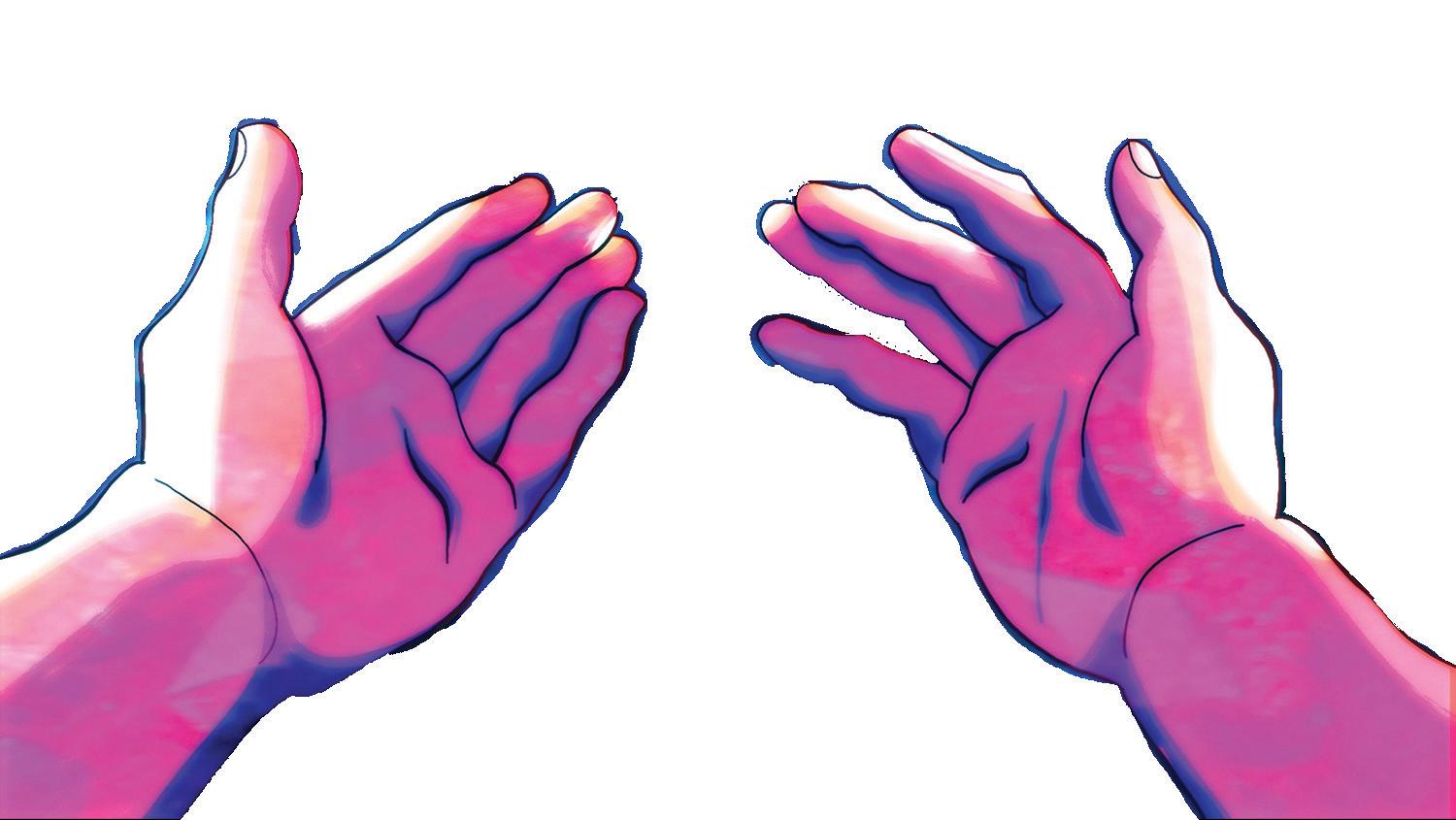









ART • 27
“It’s very important to look at a lot of animations and not just Disney and Pixar,” Van de Beek said. “There are a lot of interesting things coming out of France and Canada at the moment.”
Animation often captures young hearts and minds. With colorful characters, exciting adventures and wacky sound effects, animated shows are a big hit for young children. However, animation is not only aimed at children.
“The animation styles for children all have very bright colors, simple stories and a lot of repetition,” Van de Beek said. “Animation for adults is much faster-paced, it doesn’t repeat things and characters are more complicated.”
However, as kids grow older and life gets busier, things like school or work can take over their time, and the shows that were a part of their daily routine start to become cherished memories from their childhood. Neverthe less, many adults still have personal connections to memora ble animations from their childhood. Argast explains how adult animation can be just as powerful.


I think that animation geared toward chil- dren is usually more mass-produced,” Argast said. “Animation that is made for more adult audiences often has a bit more care put into it. I’d say that the messages and themes present in these adult animations are just as impactful as themes in film.”
Animation for different ages is not the only difference in the industry. Chai notes a potential disparity in exposure and exploration within animation in the United States, which could lead to the popularity of animation declining

“They [adult animation studios] have all sorts of films — sad ones and ones that evoke social change,” Chai said. “Maybe we just don’t have as much exposure to them here in the States, or people don’t search them out.”

Among the myriad other forms of visual art, animation stands out as one of the most versatile, but also one of the most difficult to produce since nothing exists before an animation is created.
“You have to create absolutely everything,” Van de Beek said. “If you want to animate a sunset, you have to design it, you have to plan everything and you have to stick to that — it takes a lot of discipline.”
Despite the challenges and setbacks, animation gives the artist complete freedom and power over the world they are creating. The animator has total control over the element of time and what’s on the screen, something that people all over the world can enjoy.



“I think animation is one of the most freeing mediums,” Argast said. “Some of the most ground-breaking projects come from animation.” Similarly, animation differs from other medi
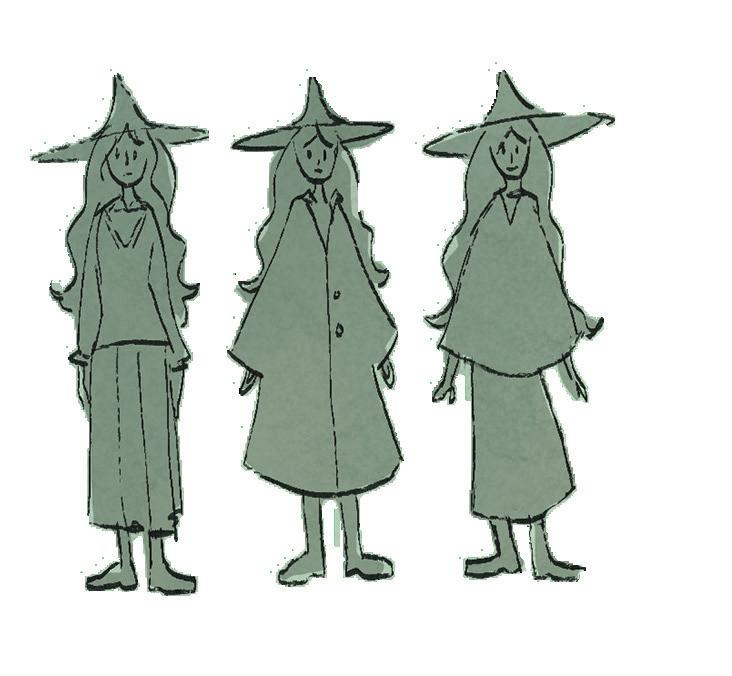




Did you find all 12 stars? They correspond to films below produced by Little Fluffy Clouds. Check out their website below!







 by ARJUN BHARAT, KAITLYN GONZALEZ-ARCEO,
by ARJUN BHARAT, KAITLYN GONZALEZ-ARCEO,
the visual aspect of movies.
“It [animation] is really customizable,” Kim said. “You can portray a lot of different things with it.”
It also provides a personalized base on which viewers can superimpose their own interpretations of the art. More abstract projects often exhibit this trait, while less interpretive projects don’t. One way to accomplish this is by being ambiguous about the type of character portrayed in the film.

“If you want different people to be able to project their feelings on the animation, you don’t want to tie yourself down to a specif ic character,” Van de Beek said. “Sometimes you want to stray away from that, do it a little bit more abstract.”
However, some people consider it detri mental for art forms to be compared to each other. Many people believe that individual styles are best ap preciated in the absence of competition.
“Moving forward, we should find a way to bridge the two mediums rather than ask which is better,” Argast said. “Instead, we should focus on each medium’s strengths and how those strengths can be used to create beautiful projects.”
Many animators have a special connection to the art form, often rooted beneath the surface. Chai explains why animation is especially remarkable to him.
“I watched a set of animated documentaries, and in animating them, the artists and the direc-


tors are able to take it to another level,” Chai said. “It’s not just watching the lions eating those sheep, but they could show some more different metaphorical interpretations or different visual interpretations that add to the whole story.”

To many professionals, animation is special because of the room for creativity and imagination. Oftentimes, artists will adapt already existing storylines or movies into animation, offering a differing perception from the artist’s point of view.
Artists, as a whole, constantly put themselves in front of their audience and hope for the best. This can be nerve-wracking, especially for animators — many of whom work in
“They [animators] are working for weeks, months on end,” Van de Beek said. “How’s that going to work out when it’s shown to people? I think with any art form, you just step in front of the audience with what you’ve created. That’s sometimes a scary process.”
However, that’s true of any art form, and the difference in medium doesn’t make one story inherently better than another.
“Animation is not better at telling a story than other mediums,” Van de Beek said. “I think you should be able to express yourself in anything.”









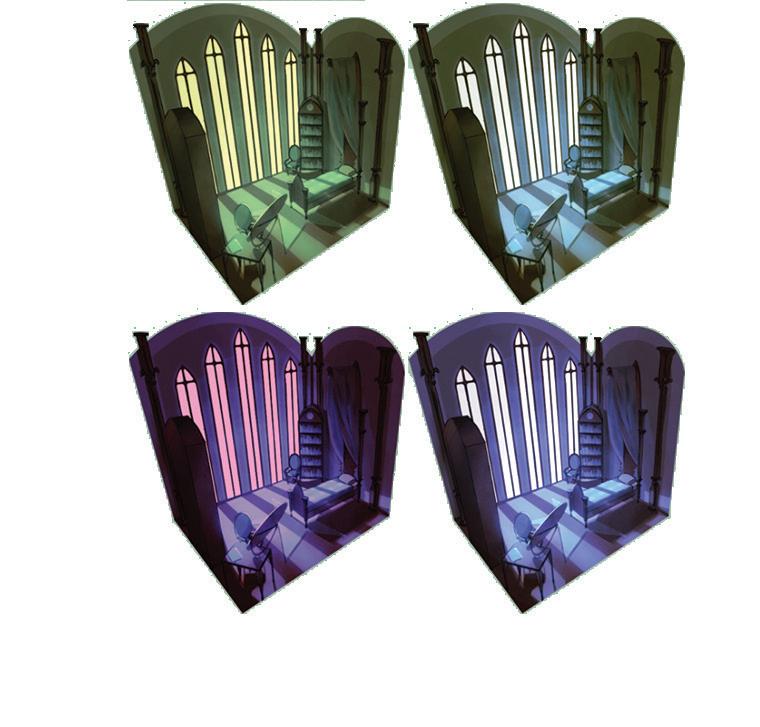




Text and
MARTINA MEYERFREUND and ALICE SHEFFER • Art by RENNY ARGAST, LITTLE FLUFFY CLOUDS and ALICE SHEFFER ART • 29
Design

TTAthletic Artistry Artistry Athletic
Sports are often seen purely as acts of technical skill, but at what point can they also be considered forms of art?
raditionally, art is defined as the application of human skill and creativity to a physical object or performance, evoking some emotion or reaction. When most think about artists they know, they consider painters, sculptors and musicians, often overlooking the artistic talents of one group in particular: athletes. Sports, often thought of as solely applications of physical, mental and technical skills, can also utilize this creativity in order to create a beautiful end product, reminiscent of what most people consider art.
Athletes, like traditional artists, perfect their craft through years of practice, dedication and discipline. Junior thrower Lia Cardwell has dedicated her time to channeling her energy and focus into producing the best throw possible.
“During my sophomore year, I spent a lot of time on the weekends, or just staying later at practice to get more reps in,” Cardwell said. “I saw quite literally a 30 foot improvement from my freshman year.”
Artistic elements of sports are also
“
reflected in the ability of an athlete to be innovative, pushing the boundaries of what is considered to be possible. This is seen particularly in trick-based sports like skateboarding, diving and ice skating. In these trick-based sports, athletes are constantly striving to invent and master new maneuvers and skills. However, junior ice skater Briar Dorogusker has seen that these new tricks can come at a cost as creative ingenuity and storytelling is swapped for pure mastery of technical skill.
nent in other sports, pushing boundaries of what is possible can be seen in every sport. According to Cardwell, this creativity is necessary for athletes to hone their athletic skills.
“There’s room for interpretation because everyone is coming from different standpoints in terms of strength and technique,” Cardwell said. “That means that their technique is going to develop differently.”
Athletes express themselves in not only the way they play, but their expressions on and off the playing field.”
Anne Threlkeld, 12
“A lot of people see [ice skating] as moving away from being artistic and just becoming a jumping routine with some moves in between,” Dorogusker said.
Although innovation is less promi-

As a thrower, Cardwell has learned the importance of being adaptable and open to new techniques in her throws to find what works best for her.
“[In throwing] there is a lot of room for expression in addition to technical ability, especially because we’re rotating in a circle and trying to move a heavy
“object as far as we can,” Cardwell said. “In this process, a lot of different techniques can develop and a lot of people have really good rhythm and tempo, and that helps them reach the common goal of throwing it a further distance. But, there’s also so much room for creativity and expression.”
also a ton of creativity involved in exploring unique movements.”
Paly athletes like Threlkeld push themselves to enhance their abilities both physically and intellectually.
There’s so many interpretations of what a sport should look like, and how it should be played and at what competitive level it should be at.”
Alena Lotterer, 12
In contrast, junior Roan Haney, a swimmer and water polo player, believes that originality in games can be difficult to achieve at times in team sports.
“It’s pretty hard to make up new creative ways to play my sport as everything is pretty well thought out by the coaches, but sometimes if the players have good enough chemistry together they can understand each other’s playing styles and improve on the go to link up with each other and create an effective play,” Haney said.
The creative process expands beyond an individual athlete, to encompass the collaborative efforts of coaches, choreographers, playmakers and teammates. Together they can craft performances and skills that elicit emotions and reflect innovation.
As a rock climber, senior Anne Threlkeld believes that artistry can be shown in sports through the problem-solving required to perform at a high level.
“In terms of balancing the technical aspect and the creativity, in climbing there are often very general technical rules like keeping your hips into the wall, but it’s super fun because each climb is so unique and can require completely different mental aspects and movements, and some problems can even break the rules entirely,” Threlkeld said.
These general technique rules give climbers a base guideline to work off of but allow for the athlete to challenge their usual techniques and dive into different approaches.
“I think the range of skills needed for climbing is super broad,” Threlkeld said. “It’s obviously helpful to have the things you’d expect like finger strength, but there’s
“I think climb ing is a great form of expression because you can get anything you need out of it,” Threlkeld. “It’s a really great workout, it can be thrilling if you want, and I use it as a way to stay grounded and in the moment.”

In comparison, sophomore rower Dorin Flynn believes that team sports force ath letes to develop their creativity in different ways, as individual expression is less appli cable.
“A lot of rowing is technical and it works out best when everyone is doing the same thing,” Flynn said. “At the same time, everyone in the boat has to be creative in finding ways to blend the technique together.”

Similarly, junior videographer Gabe Boudtchencko believes that when players master the technical aspects of their sport, they can compete more. This allows them to display their personal strengths.
“I think playing sports itself starts out very technical as that’s how players begin and improve, but with more experience and skill, players can move into playing creatively in games that allow for that and that’s where all the fun is,” Boudtchenko said.
Making decisions in game-like situations helps improve team trust, and can even enhance the communication between teammates.
“I improvise in my sport often, a big part of playing a good team is improvising to each player’s play style, and nothing is ever as per fect as you imagine,” Haney said.





Artistry ART • 31
Sports also create time-critical decisions which can manifest themselves in forms of art due to on-the-spot thinking and improvisation. Senior lacrosse player Eliza Gaither has been able to express her creative identity through playing the sport.
“I was able to collaborate with my teammates to develop new plays, share my opinions and create new forms of art,” Gaither said. “This in itself is an expression of art because it challenged my creative and artistic thinking.”
Alena Lotterer, 12 “
Competition in itself is an art just because there’s so much that goes into it on the mental side and the physical side.”
“There’s just so much that goes into it [diving] to make it look easy, and to make it look pretty, just the way you have to do all these things with your body and make it look easy when it’s really not,” Lotterer said. This high technical skill and focus required to execute a flawless dive emphasize the pure athleticism of divers, but also the finesse necessary to dive competitively.
lete’s scores. Like in many sports, these perspectives leave room for subjective scoring.
“There’s so many interpretations of what a sport should look like, and how it should be played and at what competitive level it should be at,” Lotterer said.
These impressive athletic performances can draw an emotional response from an audience, drawing parallels to the aims of traditional artwork.
“I think sports can be seen as a form of art because, especially at a pro level, there is so much that goes into each team, so it displays some of the emotion and work that people have put into their sport,” Haney said.
Even in team sports, the individual actions of players are shown in their techniques and decision-making. According to senior diver Alena Lotterer, these individual details are what make many consider sports a form of art.
“I think in general, sports are considered art when you’re doing something really impressive with your body,” Lotterer said.
Based on these impressive diving maneuvers, divers are scored by judges, leaving expert opinions to influence ath-

“Athletes express themselves in not only the way they play, but their expressions on and off the playing field,” Threlkeld said. “Sports bring out intense emotion in the players and the fans and capturing the athletes’ raw emotional reactions is the most prominent way I’ve seen expression from players.”
For senior photographer Tyler Wong, these moments of emotional reaction


show the dedication and joy that sports bring out in athletes and communities.
“When photographing, the celebrations are what really stand out and choreographing them is a really cool part,” Wong said. “I love photographing these moments especially.”
“
Capturing these moments in sports also allows photographers and videographers to develop their own creative identity as they learn about their art and the unpredictable nature of athletics. This media can tell the story of sports games while showcasing impressive physical achievements and human emotions.
“Though I have very little control over what I capture in a game, the way I approach creating something unique from everything I film is how I express my creative identity.”
As athletes continue to redefine their presence in the game it is important to understand all forms of artistic expression.”
Eliza Gaither, 12
“I use videography as a means of expressing my creative identity through all my published work,” Boudtchenko said.
While competing, many athletes also express their creativity through their team traditions and style choices, showing off their individuality on their teams. Senior baseball player Nate Donaker has learned the importance of competition and how it can create a sense of critical thinking, creativity, teamwork and mental toughness, while contrasting his technical skills with forms of self-expression.
“I like to have a lot of style in the field,” Donaker said. “I have bright red batting gloves which often match with my bright red cleats, and it allows me to

stand out on the field.”
Ultimately, creativity in sports comes from practiced skill and spur of the moment improvisation, leading to these captured moments of athletics. For Lotterer, this is what makes sports an art.
“Competition in itself is an art just because there’s so much that goes into it on the mental side and the physical side,” Lotterer said.
Traditional definitions of art often overlook the roles athletes play in artistic creation, neglecting the creative outlets sports provide for athletes around the world.
“Many view sports from a strictly physical and mental perspective,” Gaither said. “As athletes continue to redefine their presence in the game it is important to understand all forms of artistic expression.”
Text and design by MAEVA HERBERTPAZ, JAKE PAPP and GIN WILLIAMS • Photo illustrations by MAEVA HERBERTPAZ • Photos courtesy of CELESTE BATES and KENNEDY DO



FAPassion Passed On

At Paly, many students put a strong emphasis on a high standard for core academics, oftentimes overlooking classes in the Visual and Performing Arts (VAPA) department


FWillner Leads the Band
or Paly art teachers, teaching is a way for them to share their passion with other students. Paly band teacher Jeff Willner enjoys seeing his students progress throughout the year. Community participation is his favorite part of the classes he teaches.

“It’s gotten to the point where that’s [the community is] more important to me than the absolute perfect performance,” Willner said. “As long as everyone in the room’s engaged and we’re communicating, [occasional mistakes] don’t bother me.”
Originally, Willner began teaching because he saw it as a logical step in his career. Now, becoming a band director has exposed him to many genres of music, allowing him to help his students adapt to different musical styles like jazz, classical music and orchestral pieces.
“It’s enabled me to use so much of what I’ve listened to over the years,” Willner said.
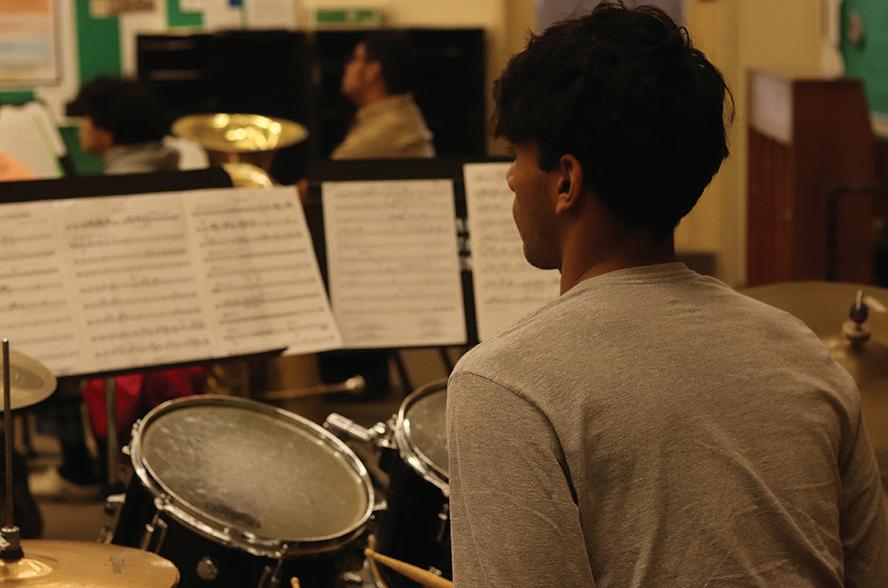

Text, design and art by SOPHIA DONG, KAYLEY KO and FALLON PORTER
34 • cmagazine.org
[featured artist]
Williamson Dances Away

Paly dance coach and English teacher Alanna William son views dance as a stress reliever, for her students and herself.
“It helps to have the dance team because I get to pursue dancing as a separate thing [passion],” Williamson said. “It’s a stress reliever for sure, when real work is stressful I feel that dance is a great outlet.”
Williamson, a trained dancer, became interested in becoming the coach for Paly dance after watching the dance team perform on the quad. Combining her passion for dance and teaching gave her incentive to take on the position.
“Getting to coach [Paly dance] and helping pass on my knowledge [of dance] allowed me to go back to it as an adult,” Williamson said. “I got to start training again, and now I get to do it on my own as a professional dancer, so that’s great, too.”
Since current child development teacher Hilary McDaniel started the dance team in 2010, it has served as a pivotal part of Paly’s football and basketball games as well as performing at school events, adding to the school spirit. Williamson has enjoyed watching the team evolve throughout the years and how the dancers connect.
“I don’t do this [coaching] for anything else other than that I truly love coaching and I really believe in the girls,” said Williamson. “It doesn’t feel like work, it feels like something fun.”
Gallagher Captures Hearts
Photography teacher Kenna Gallagher continually fuels their passion for photography directly from the classroom.
“I have so much more time to deep-dive into the nuances [of photography] because I need to have that knowledge base in order to teach it to students, so it actually lets me create more than I normally would have time for if I wasn’t teaching [photography],” Gallagher said. “It’s all I’m surrounded by when I’m at work for 10 hours a day.”

Not only does Gallagher believe that photography is a valuable and useful skill, they also believe that it helps in areas such as advertising, as photography is a more popular art medium, which makes it highly marketable.
“People want their lives documented,” Gallagher said. “People want their weddings documented, people want their moments and are willing to pay for it by somebody who knows the craft.”
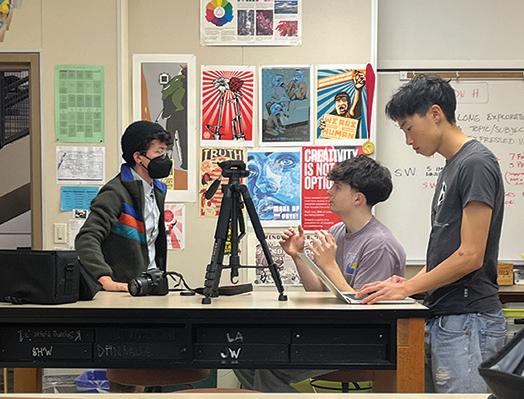

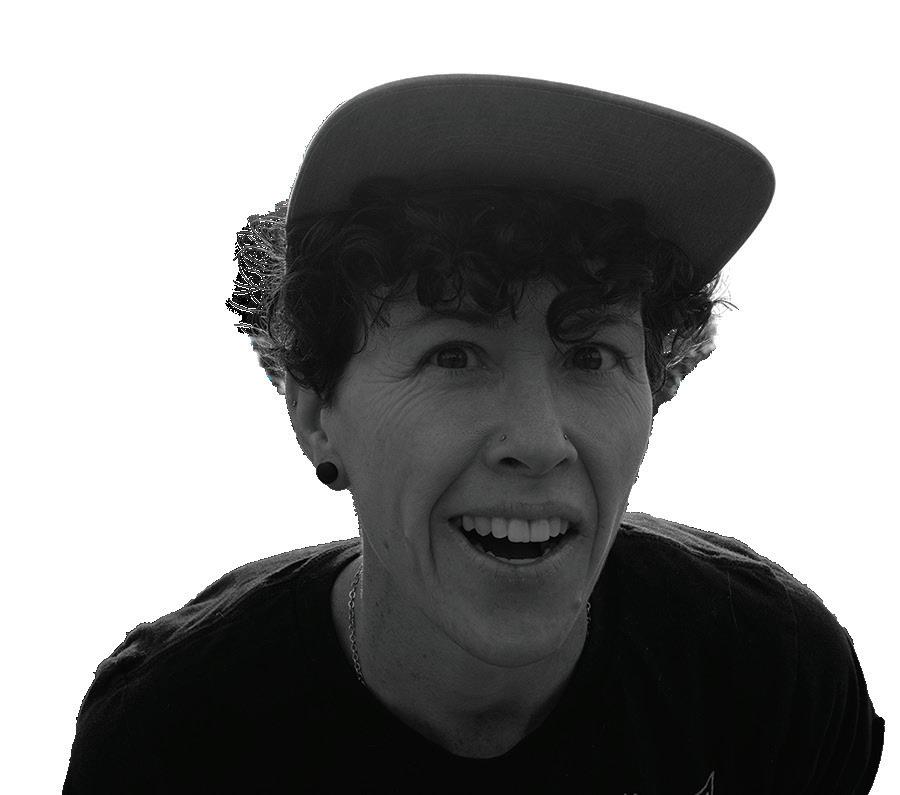


ART • 35
Muñoz Colors Students’ Lives

rt spectrum teacher Tree Muñoz also believes that art is like a puzzle, with many components
“It is amazing to see the truth that people reveal through their artwork that they don’t talk about,”
As an art teacher, Muñoz has a lot of dedication, particularly when it comes to preparing her classroom for each of her five classes. Sometimes, they find themselves performing trivial tasks, including restocking art sup-
“If [I’m] not [setting up class], then I’ll take clay things out of the kiln or put them in,” Muñoz said. “I don’t usually
Muñoz finds it enjoyable to teach their students how to gain perspective and express themselves through their artwork. Muñoz finds that such strategies compel students to
“They’ll be able to tap into something that they didn’t know,” Muñoz said. “I try to give them materials and tools in the inspiration or the prompts to get those emotions moving on
She finds that students putting their thoughts on paper often “You just get a plain piece of paper and a box of crayons [with a goal to] make this [the paper] as covered with crayons as you possibly can,” Muñoz said. “When they’re done, they just don’t feel the same… Putting it [your emotions] outside of yourself [in art] creates space.”






36 • cmagazine.org



Bond Taps into Rhythm
As a lifelong dancer, Alyssa Bond always saw teaching dance as a natural career path.
“I always say I didn’t have the guts to go to New York and try to make it as a dancer or go to LA., that just that wasn’t me, I just knew that about my personality,” Bond said. “I feel very lucky that I knew that early on.”
Bond observes that many students take dance as an alternative to regular P.E. to fill their P.E. credits. However, by the end of the year, she finds that many of her students are using dance as an outlet.
“I always love the feedback that I get at the end of the year from parents writing to me, explaining how surprising it was that their kid had a newfound passion for dance,” said Bond. It’s also cool to hear students just telling me how they appreciate that they can come to dance and they get to totally turn off their brains.”
Bond enjoys hearing the impact that dance has made on the students across all of her classes. Whether they’re experienced or not, utilizing dance as a mid-day break can alleviate the stress of everyday school life.
“With dance, there’s a lot that you’re doing with your body that’s different from normal, but at least they’re not sitting at a desk,” said Bond. “They’re not worried about their tests that are coming up in the next class, instead they just focus on the music and the movement. This is what will have a lasting impression on them even if they don’t dance afterward.”



ART • 37
Classics Contemporary
As music evolves from current to timeless, C Magazine asked the local community which songs from this generation they think will become classic
As someone walks into a grocery store or turns on their car radio, it’s common to hear similar melodies of songs that never go out of fashion, or are timeless. “Sweet Caroline” by Neil Diamond, “Dancing Queen” by ABBA and other iconic songs hold a special place in people’s hearts as classics. Paly choir teacher and musician Michael Najar connects a song’s lifespan to its melody.
“One of the things that helps a song become timeless is a simple melody, that is [also] a little strange,” Najar said. “Oddly enough, those two things make a huge difference.”
Stanford choir member Sawyer Lai also associates a song’s memorability with its sound.
“One factor is having catchy melodies that’s easy to learn and to sing along with,” Lai said. “Another thing is that lyrics are a big part of it; if you have quality lyrics that are memorable or profound or engaging it’s easy for listeners to latch on to. A song is more memorable simply because it’s easier for people to replicate.”
Different generations develop unique music tastes due to the


societal trends of that time, so they have various interpretations of what a timeless song is. Through the shift from physical to digital media, the way people experience music has changed — therefore, there’s no objective definition of a timeless song.
“It’s sociologically impossible not to be timeless because, between the ages of 13 to 17, your brains are just ready to accept what’s being offered to you.” Najar said. “The way we even hear music is different, there is a chance that the next few years will change the way we consume and feel music. So timelessness is subjective.”
According to Najar, songs like “All the Single Ladies” by Beyonce, with simple melodies and unique bridge, have grown timeless and iconic. Many would say that current popular artists like Taylor Swift or Ed Sheeran have the potential to become timeless in the future as well
With mentions of songs like “Ophelia,” “Just Wanna Rock” and more, C Mag asked the community which songs they consider as timeless, and songs they think will become timeless in later generations.


Uzi Vert

“A timeless song is ‘Love’ by Keyshia Cole, and a timeless song from our generation that I believe will become timeless is ‘Just Wanna Rock’ by Lil Uzi Vert. I think [it will become timeless] because when you hear the song, everyone kind of gets hype and they immediately gravitate to the dance floor. It’s a very unique kind of sound.”
— Yosief Abraham, Stanford Student
“Love” by Keyshia Cole
“Just Wanna Rock” by Lil
38 • cmagazine.org

“Something I think is going to be a timeless song by ‘Brazil’ by Declan Mckenna, because it comes back every season as soon as the weather gets warmer outside. Currently I would say a timeless song is ‘September’ by Earth, Wind & Fire, because it’s been remixed and there are different iterations.”
 — Emily Tang, 10th grade “Brazil” by Declan Mckenna
“September” by Earth, Wind, & Fire
— Emily Tang, 10th grade “Brazil” by Declan Mckenna
“September” by Earth, Wind, & Fire




“Somebody That I Used to Know” by Gotye

“I would say the song, ‘Somebody That I Used to by Gotye, is already a bit of a classic. It has this very unique beat to it, and the lyrics can be relatable to people. It’s about a failed relationship in some way, and it’s just a little bit mysterious. They were kind of a one hit wonder, I’ve never heard another song from Gotye. But the song still plays at parties, I just heard some kind of house remix of it at a frat party.
I think 30 years from now our children will be singing ‘Somebody That I Used to Know’.”
— Goerge Porteous, Stanford Student
MUSIC • 39

“
‘Ophelia’ by The Lumineers or ‘Tongue Tied’ by Grouplove is timeless because no matter how much time goes by,‘Ophelia’ is just such a great song and gives me so much nostalgia, and the same goes for ‘Tongue Tied’, it can just always put me in a great mood no matter what time it is.”

—
Natalia
Pahlavan, Stanford Student

“I think ‘Flowers’ by Miley Cyrus will end up be ing timeless because it’s iconic, it’s catchy, it’s ripe for lots and lots of parodies. I can see it in movies that’ll become classics and I could see a lot of people doing dances to it. I think songs that are fun to sing, catchy and easy are what ends up [staying timeless]”
— Alicia Szebert, Chemistry Teacher





“Reggae is such an iconic genre so I think ‘Praise Jah in the Moonlight’ will become timless since YG Marley is setting the stage for the genre’s revival in mainstream media for the coming generations.”
Praise Jah in the Moonlight” by YG Marley

— Alma Samet, 12th grade

 “Toungue Tied” by Grouplove
“Flowers” by Miley Cyrus
“Ophelia” by The Lumineers
“Toungue Tied” by Grouplove
“Flowers” by Miley Cyrus
“Ophelia” by The Lumineers
Text, design and photos by TALIA BONEH and SAACHI NAGAR 40 • cmagazine.org
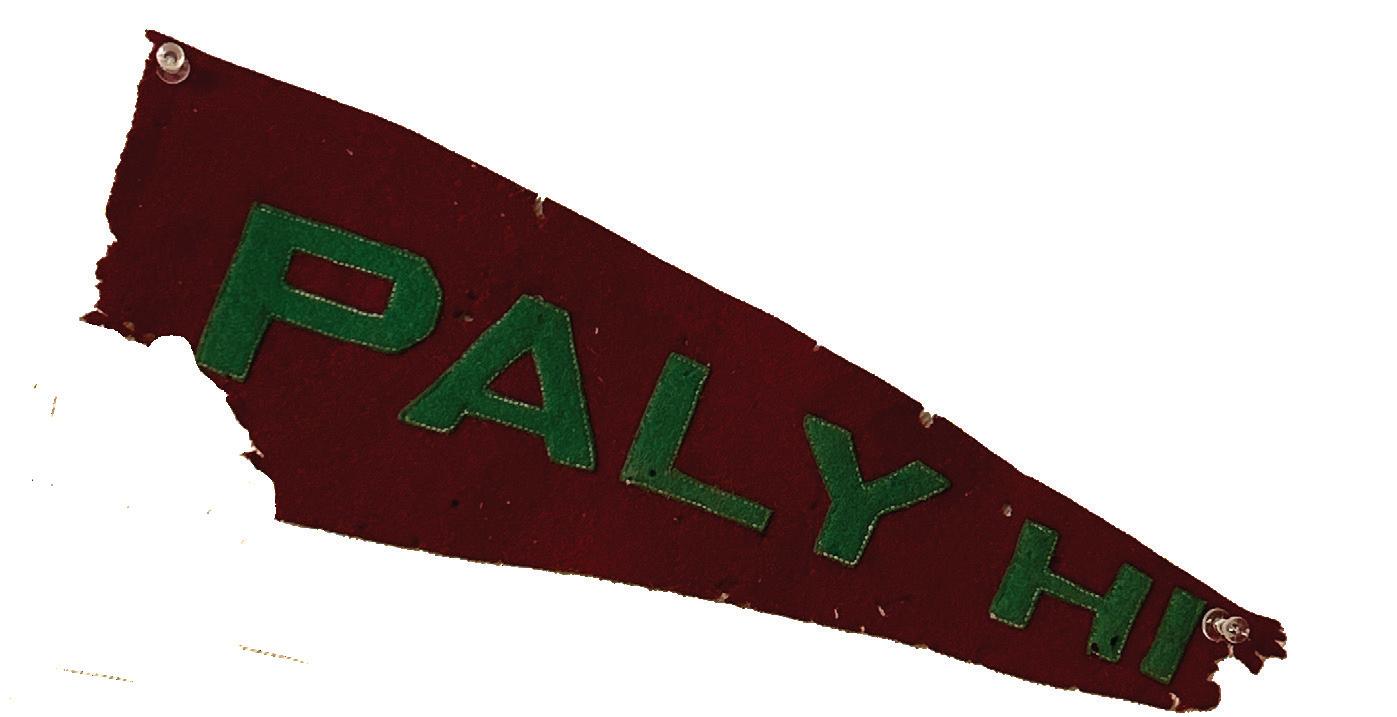


oun of CinemaTheS d

Music has set the scene for the film industry, evoking emotions through the power of sound










MUSIC • 41
Music in movies isn’t just background noise; it’s like a heartbeat that guides viewers through the highs and lows of cinematic journeys. From haunting melodies that linger long after the credits roll, to the upbeat, catchy tunes that stir our souls, the marriage of music and video production is a captivating symphony of artistry and emotion.
During the production process, filmmakers carefully curate music to set the tone for a scene, using different techniques to make the audience feel like they are immersed in the action.
Whether it be the genre of the song, the lyrics, the timing or the volume of the music inserted, different musical choices can completely change the message being conveyed in a movie scene or video clip.
Senior videographer and editor Clare Antonow uses her knowledge and experience in music to select sounds that create a cohesive video when editing her films. Currently, Antonow uses her abilities to create content for Paly publications, Madrono and InFocus.
are trying to convey, the potency of that message can be amplified by music. Analyzing and discussing this message is one of the many aspects of Paly’s Composition and Literature of Visual Media class taught by Alanna Williamson.
“Music helps us understand how the director wants us to feel, so without it, we all might have vastly different interpretations and understandings,” Williamson said.
said discovery, adventure, surprise, enlightenment -- all of which totally match what’s happening to the characters in the movie.”
“People often don’t notice music in films because it is so well done that is just seems natural.”
Clare Antonow
Videographer
Although background music affects your perception of the film and might not immediately be noticeable, viewers’ brains unconsciously use the music to follow the film’s theme.
“Music helps us understand how the director wants us to feel.”
Alanna Williamson
Composition and Literature of Visual Media teacher

During one activity in Williamson’s film elective, she plays an iconic scene for her students from Jurassic Park when the characters arrive in the park. “[the class will] listen to movie scores and then make guesses about what the music might be used for, starting with adjectives to describe the mood of the song,” Williamson said. “When I’ve played that one [the ], students have
While Antonow often uses powerful music to aid the visuals displayed in her videos, she recognizes the importance of subtle music.
“People often don’t notice music in films because it is so well done that it just seems natural,” Antonow said. “But if there was an absence of music, people would notice.”
Similarly, Williamson can hardly imagine a movie without music-making scenes complete.
“Even when we had silent films, they still used music but were unable to have dialogue,” Williamson said. “Music is so intrinsically tied to all of our emotions. If movies had no music, I think a lot of the scenes would feel awkward and empty.”
For videographers, finding music to fit the clips is a lengthy process. Identifying the overall tone of the video and matching the lengths of the video to the music clips can take hours.
Firstly, a videographer must decide the implications they want the music to have, whether that be parallel sound or contrapuntal sound.
“Parallel sound would be anything that’s enhancing the mood of the scene,” Williamson said. ”In other words, the scene is supposed to be sad, so the mu-

Ms. Williamson’s favorite soundtracks in films

Jurassic Park (1993)
Music composed by John Williams
42 • cmagazine.org
sic composed or chosen for the scene matches and deepens that. Other times, directors might choose music that is contrapuntal to the scene, which means that it opposes the mood.”
The use of different techniques is very impactful to provoke emotions in the audience and proves to be one of the most important parts of the process in filmmaking, both in the professional film and music industry as well as for individual videographers.

After deciding on the tone of the music, Bennett Hardy, a filmmaker and Paly alumnus, goes through the process of putting the music to the scene.
“Whenever music is off-putting to the film, it pretty mcuh ruins the cinimatic experience.”
Bennett Hardy
“Matching up the clips to the beat or lyrics is quite simple when you have finished editing unless it’s copyrighted,” Hardy said.
Artists often choose to copyright their songs, so that other people cannot use them to make a profit without the artist’s permission. Getting permission is sometimes difficult, as filmmakers have to get a license stating how they can use the music and what they will pay the creator to use it. To avoid these monetary costs, Hardy suggests a different method that, although time-consuming, can reap the same reward.

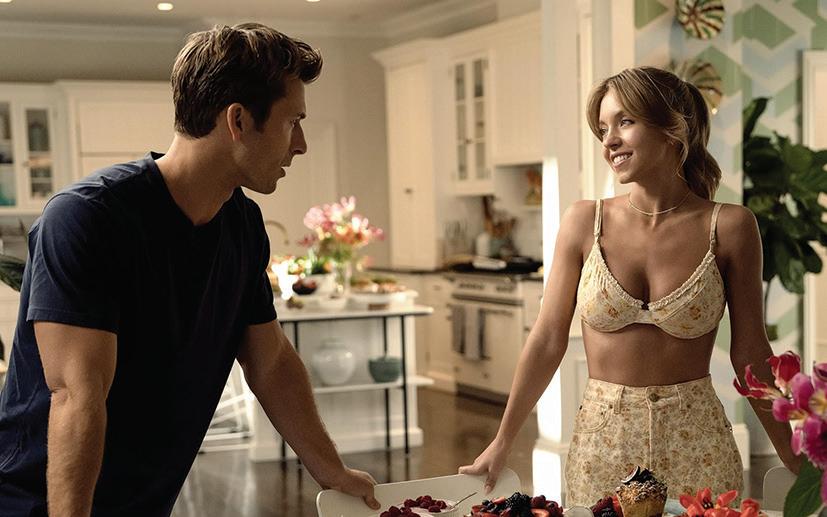
“I also can get other people to help me match the music,” Hardy said. “So for a soundtrack, I can get a friend to make it with me, and that takes around 10 hours [to] 11 hours to fully fix it, or I can find it on Free Sound or different non-copyrighted music platforms.”
Despite the lengthy process, the end product almost always pays off. With melodies and chords enhancing the footage, filmmakers can effectively share their message and tell a story. However, a soundtrack holding such a significant role in the tones and themes of films may cause a possibility of portraying the wrong message to the audience.
“Whenever music is off-putting to the film, it pretty much ruins the cinematic experience,” Hardy said. “If a filmmaker
and uses music from that age group to sympathize with the audience, it feels very off-putting.”
Videographers must think carefully about the music they choose to include and the effect they want it to have on the audience.
“The film industry would not exist without music before talkies were invented,” Hardy said. “Short films consisted of just music with the visuals, and then a cut to dialogue.
Talkies or “talking pictures” are named after the use of recorded dialogue that played in sync with images on screen drawing contrast to older movies of the silent film era.
Warner Brothers Studio was one of the first of its time to develop sound technology and used it to create Don Juan in 1926 which was the first full-length movie to feature synchronized score and sound effects.
As we approach one hundred years since this film’s trailblazing use of sound, it is incredible to see how much of an impact it has had on films and the emotion they convey. This evolution also proves promising for film buffs and the future of the film industry.

Anyone but You (2023)
Music composed by Este Haim and Christopher Stracey

Interstellar (2014)
Music composed by Hans Zimmer
Text and design by MARY HENDERSON, SONYA KUZMICHEVA and KATELYN PEGG • Photos by BENNETT HARDY
Filmmaker
MUSIC • 43


























 Text and design by DYLAN BERGER, ANIKA RAFFLE and ISAAC TELYAZ •
Text and design by DYLAN BERGER, ANIKA RAFFLE and ISAAC TELYAZ •
































































































































 by ARJUN BHARAT, KAITLYN GONZALEZ-ARCEO,
by ARJUN BHARAT, KAITLYN GONZALEZ-ARCEO,
































































 — Emily Tang, 10th grade “Brazil” by Declan Mckenna
“September” by Earth, Wind, & Fire
— Emily Tang, 10th grade “Brazil” by Declan Mckenna
“September” by Earth, Wind, & Fire









































